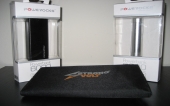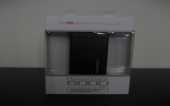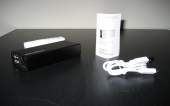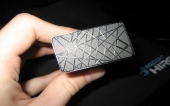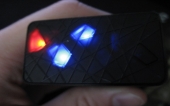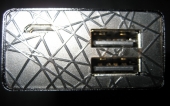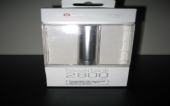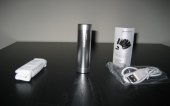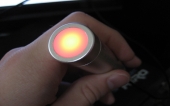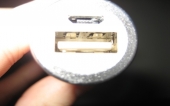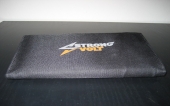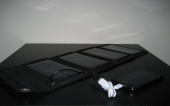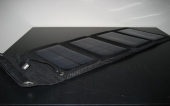Powerocks PowerBank 6000, 2800 and Strongvolt Solar 7 Charger
Do you have a mobile device? Does it have a battery? Do you use your mobile device often? Does it’s battery run dry every now and again? I know that I just asked a huge, overarching question, that could totally apply to everyone, but they were legitimate. I know both from anecdotes and personal experience that depending on usage, time of the year, solar alignment, and your karma, electronic devices can either last for days, or several hours. So to resolve this dilemma I have prepared 3 alternative energy sources. Two of these you have to charge yourself; as for the third, it draws energy from that giant nuclear furnace in the sky. Without further ado, let’s begin the alternative energy trifecta.
Powerocks PowerBank 6000 and 2800
First up today we have the Powerocks PowerBank 6000: Rose Stone. As you may have guessed the 6000 stands for the mAh that each charge pack can store. (Before I continue, I’d like to point out that all of these tests were preformed with my Galaxy SII and it’s 1650mAh battery.) The Rose Stone comes with it’s charge cable; it has to be charged via a USB charger leading to it’s mini-USB port, instructions, and a velvet carrying bag. At the ends of it’s long quadrangular body, one side features it’s native charge port, and the 2 USB out ports, so you can charge up to two devices simultaneously. On the other side is the charge indicator: Push the button, and up to four LEDs light up. Each LED is about 25% of the maximum charge. So, if four of them light up, you can assume that you’re at full charge and good to go. While charging, the LEDs are always on: some will be blue, to indicate a charged quartile, while others will be red, indicating that there is still a quarter or more left to charge. I left the Rose Stone to charge overnight after depleting it fully, and once I woke in the morning, it was ready to go. I then ran my Galaxy SII dry, and let it charge from the Rose Stone. (A heads up, to begin charging, you have to hit the LED test button). Periodically checking on it, I saw that over the course of about 3 hours, my battery was back to full. So, the final result is that the Rose Stone can charge a phone of around 1500mAh battery, 3 times fully from a full charge on it’s own battery, and each charge would take about 3 hours. Not bad for a sleek, compact power pack. The MSRP for this little box is $69.99.
Next up in line is the Rose Stone’s little sister: The Powerocks Super Magicstick 2800.
Packaged nearly identically to the Rose Stone, the Magicstick is smaller in both size and capacity. There is a button/LED at one of the ends to check the charge levels, with three color coded responses. Red for under 25%, green for between 25% and 75%, and blue for 75% to max. The slick Magicstick charged itself from the same port and cord as the Rose Stone in about 5 hours. The same test was preformed with my phone, and from a dry battery, the Magicstick was able to charge my phone in about the same time: 182 minutes, as apposed to the 202 minutes the Rose Stone managed to charge the same phone in. The Magicstick retails for $49.99.
StrongVolt Solar 7
With the sister battery packs done, we have one last order of business to attend to. This alternative energy solution doesn’t need to be charged.
It’s the Strong Volt Solar 7 charger, and boy is it neat to use. It’s small, compact, and actually functions! According to technical specifications, the charger is 17% efficient, so keep that in mind with it’s 1000mA, 7 watt output. This solar charger folds up into itself for easy carry, and has a build in cord with a USB out port on it. Simply attach your device’s charge cord, place it in the sun, and you’re good to go. When I first got my hands on this thing, I though that it looked a bit flimsy, and that it wouldn’t be able to charge a phone. I was wrong. In the same situation as the previous two tests: Dry Galaxy SII battery, and a pleasant, cloudless Floridian day, the Strong Volt Solar 7 did legitimately pull it’s weight. Over the course of one 20 minutes lunch outside, it managed to charge my phone 10%. That’s not too shabby for something that didn’t need me to find an outlet, and sit next to it. Another boon to this device it that it has securement points for easy attachment to a backpack during a hike. Provided you are in the sun, you can charge on the go. It will even, with limited success, work on an overcast day. I mean, the little 7 watt charger will take a much longer time to charge, but I was able to weasel out 2% of a charge on my phone during the same lunch period. The 7 volt model retails for about $55.
Conclusion
So there you go. 3 easy solutions to a device dying prematurely on you. Two you have to precharge, but will charge your phone quickly, while the third needs no outlet, but will charge your phone at a slower pace than the other devices (it also doesn’t work at night).
P.S.
Here’s a bit of interesting news. In the last couple of days, I repeated the tests with my Nexus 7 (2013) and discovered that the Rose Stone 6000 can, and absolutely will charge the 3950mAh battery. The smaller MagicStick will put a dent in it, but it wont charge it fully. As for the solar charger, the charge time is a bit slower, about 4% per 20 minutes, (I tried my best to keep the time of day and angle of the sun constant).
